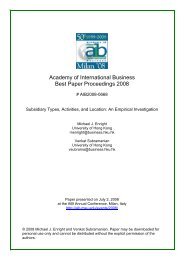AIB 2012 Conference Proceedings - Academy of International ...
AIB 2012 Conference Proceedings - Academy of International ...
AIB 2012 Conference Proceedings - Academy of International ...
You also want an ePaper? Increase the reach of your titles
YUMPU automatically turns print PDFs into web optimized ePapers that Google loves.
MONDAY<br />
A Comparative Analysis <strong>of</strong> the Effects <strong>of</strong> Different Forms <strong>of</strong> Team Diversity on Global Virtual Team Performance<br />
Vas Taras, University <strong>of</strong> North Carolina Greensboro<br />
Pawel Bryla , University <strong>of</strong> Lodz<br />
Dan V. Caprar, University <strong>of</strong> New South Wales<br />
Alfredo Jimenez, University <strong>of</strong> Burgos<br />
Peter Magnusson, Florida <strong>International</strong> University<br />
Riikka Sarala, University <strong>of</strong> North Carolina, Greensboro<br />
<strong>International</strong> on-line collaboration is an inherent feature <strong>of</strong> the modern workplace. Global virtual teams can<br />
enjoy benefits but can also experience challenges due to diversity <strong>of</strong> member backgrounds, values, and<br />
geographic dispersion. Advancing earlier research on the relationship between team diversity and performance,<br />
the novelty <strong>of</strong> the present study is that it <strong>of</strong>fers a simultaneous comparative evaluation <strong>of</strong> the strength and the<br />
direction <strong>of</strong> the effects <strong>of</strong> various dimensions <strong>of</strong> diversity – demographic, geographic, time-zone, cultural,<br />
institutional, and perceived – on team performance. The data were collected as a part <strong>of</strong> a large academic<br />
experiential learning exercise that involved over a thousand undergraduate and MBA students from 26 countries<br />
working together in international teams <strong>of</strong> four-eight students for about eight weeks. The results confirmed a<br />
significant effect <strong>of</strong> diversity on team performance, but also revealed substantial differences <strong>of</strong> the effect<br />
strength and direction across diversity dimensions and measures. (For more information, please contact: Vas<br />
Taras, University <strong>of</strong> North Carolina Greensboro, USA: v_taras@uncg.edu)<br />
Multinational Teams: Cultural Differences, Interactions, Organizational Context, and Performance<br />
Aida Hajro, Brunel University<br />
Markus Pudelko, Tübingen University<br />
Cristina Gibson, University <strong>of</strong> Western Australia<br />
This paper extents the literature on multinational teams (MNTs) in a series <strong>of</strong> ways: First, we demonstrate that<br />
the relationship between national cultural diversity and MNT performance is mediated by inter-cultural team<br />
interactions. Furthermore, we show that MNT interaction can lead to a process <strong>of</strong> hybridization in which<br />
cognitive convergence between team members takes place so that they can negotiate and manage successfully<br />
their cultural differences. Next, we re-veal how the macro-organizational context, in this study operationalized<br />
by corporate strategy, can either facilitate or impair the process <strong>of</strong> the inner-team negotiation <strong>of</strong> cultural<br />
differences, resulting in different degrees <strong>of</strong> team performance. Our study is based on 162 in-depth inter-views<br />
with team members and leaders across 89 different teams from eleven different companies plus extensive<br />
participant observations. (For more information, please contact: Aida Hajro, Brunel University, United Kingdom:<br />
aida.hajro@brunel.ac.uk)<br />
Getting the Best from Cultural Diversity: Psychological and Structural Elements in a Five T-model<br />
Geetha Garib, UCL<br />
Previous models <strong>of</strong> diversity effects have either sought to promote diversity by monitoring its performance (De<br />
Anca & Vazquez, 2007) or included task characteristics and psychological aspects (Knippenberg et. al., 2004) in<br />
order to manage diversity. However, diversity models have not yet combined both structural and psychological<br />
elements. The Five T model (Training, Time, Talk, Threat to the majority and Together) builds further on the<br />
CEM <strong>of</strong> Knippenberg et. al (2004) and combines structural and psychological elements to manage cultural<br />
diversity effectively, as it includes main elements to decrease negative effects and increase positive effects <strong>of</strong><br />
cultural diversity. (For more information, please contact: Geetha Garib, UCL, United Kingdom: y.r.garib@uvt.nl)<br />
<strong>AIB</strong> <strong>2012</strong> <strong>Conference</strong> <strong>Proceedings</strong><br />
Page 135

















